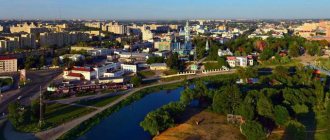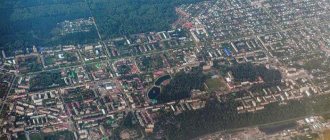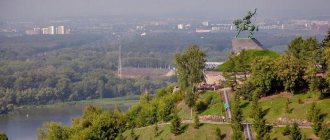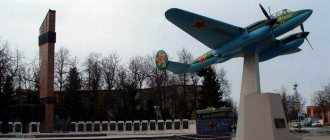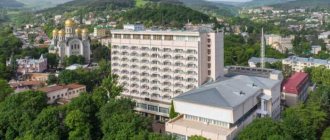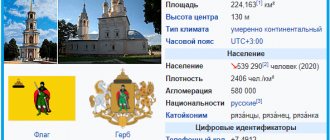The administrative center of the Tambov region is the city of Tambov, which was built on a picturesque hill. This place is washed by two rivers: Studenetsa and Tsna.
Tambov was founded in 1636, although settlements of ancient inhabitants existed here for a very long time.
The city is interesting for its historical sights, museums, cultural events, and festivals that constantly take place here. Therefore, people who move to Tambov for permanent residence will find where to go, what to do and where to relax with friends and children.
General information about the city
Tambov is a small city in the European part of the Russian Federation. It is the administrative center of the region and district. The city does not belong to the Tambov district, since it is separated into an independent urban district, which is divided into three districts - Leninsky, Oktyabrsky and Sovetsky.
Tambov is located relatively close to Moscow – 480 kilometers to the southeast. The total urban area is 91 square kilometers. The population of Tambov in 2016 is 288,414 people, the population density is 3,173 people per square kilometer. The history of the city is full of significant events.
origin of name
There are two main versions of the origin of the name of the city of Tambov. The city's population adheres to the second option. The first version is historical. According to linguistic analysis of the word “Tambov”, it comes from the Moksha name of the supposed site of construction of the “Tonbov” fortress. This is what the locals called the river, on the banks of which they began to build fortress walls. When translated from Moksha, the word means “pool.” The second version is legendary. According to local legends, enemy raids on the fortress always ended in failure. Therefore, the nomads, although they expected defeat, justified their failure with loud cries of “God is there!”
Foundation of the city of Tambov
By order of the sovereign of Tsar Mikhail Fedorovich, the steward and Shatsk governor Roman Boborykin goes to the Wild Field to establish a stronghold there. On April 17, 1636, Boborykin chooses a place reliably protected by nature itself from any enemy attack. It was located on a hill near the confluence of two rivers - Tsna and Studenets. A fort and the Kremlin (the city itself) were built on the hill.
The fortress was built thoroughly: the walls were cut from oak in two rows. The tied oak trunks were additionally strengthened with earthen backfill. For reinforcement, watchtowers were built. The six-meter walls seemed an impregnable barrier. To protect the city from the southern side, Boborykin ordered to dig a ditch connecting the Studenets River with Tsna. The ditch was filling with water. An additional water barrier turned the city into an island. A garrison of thousands was sent to a permanent location in the Tambov fortress. The population of the city immediately increased significantly.
To protect Muscovite Rus' from raids by the Nogais and Crimean Tatars, in addition to Tambov, a number of outposts and fortresses were built on the southern border of the state. A lot of effort was put in. The great burden of construction fell on the shoulders of the then small local population. But the efforts were worth the result: a reliable barrier stood in the way of the Tatar raids.
Population of the Wild Field
The lands where Tambov and many ancient cities are located are located on the territory that was once called the Wild Field. These were uncultivated fertile steppes, suitable for agriculture and practically uninhabited. Raids by nomadic tribes prevented the development of these places, located on the border with Russia. Part of the Wild Field was under the control of the Don, Dnieper and Khoper Cossacks, but this was not enough. Decisive measures were needed on the part of the state to protect the population from the attacks of nomads.
These measures included the construction of defensive structures: fortresses, earthen ramparts, fences and ditches. A guard and village service was organized. In the built fortresses and along the line of defense there was a settlement of service people. Thus, modern cities were founded: Voronezh, Orel, Yelets, Belgorod, Volgograd, Penza, Rostov, Lugansk, Donetsk, Kharkov, Kirovograd, Sumy, Nikolaev, Poltava and many others.
Development of Tambov in the first century
The built defensive fortress created the conditions for the massive resettlement of peasants here from other regions of Rus'. The population of Tambov has grown significantly in a short time. Peasants in the Tambov region sought to obtain a plot of fertile land and hide from the landowners. Their desires were partially satisfied: they received land, but feudal lords appeared in such a remote place. In 1670-1671, a peasant uprising against the oppression of the landowners took place in the Tambov region. Twice peasant detachments besieged Tambov, and both times they retreated. The uprising ended with the defeat of the rebels.
By the end of the 17th century, the city of Tambov turned into a gathering point for Russian troops to participate in the Azov campaigns. Tsar Peter I was defeated in his first campaign. This prompted the young king to quickly build a navy. Tambov peasants were mobilized to create the ships. They cut down the forest, and it was from Tambov wood that the first ships of the Russian fleet were built.
The beginning of the 18th century in the history of Tambov was marked by two main events:
1) In 1738, a new fortress was built in the city. The fire destroyed the century-old structure. And although the peasants now no longer needed the protection of the fortress or guards, the fortress wall was still erected - the threat of raids by steppe troops from the Lower Volga region and the Kuban region still existed.
2) The first educational institution was opened in Tambov. It became a garrison school for soldiers.
The population of Tambov began to increase due to increased security.
Tambov is the center of the province
The last quarter of the 18th century changed the situation of Tambov. By decree of Empress Catherine II in 1775, the number of provinces was doubled, provinces were eliminated and the boundaries of counties were changed. The replacement of the old provinces led to a change in their name; they began to be called “vicerarchates”. As a result of the implementation of the reform in 1779, the Tambov governorate was formed. It included the southern lands of the Ryazan governorship (mostly the Elatom district) and the northern regions of the Voronezh governorship. Tambov became the administrative center. The population of the city of Tambov has once again increased significantly.
The newly formed viceroyalty was significantly larger in area than the modern Tambov region. Of the modern subjects of Russia, it included areas from Mordovia and four regions - Lipetsk, Ryazan, Penza and Voronezh.
The appearance of Tambov at that time was no different from the appearance of neighboring villages. Wooden houses, thatched roofs, vegetable gardens, dirty unpaved streets. The only difference was the fortress, indicating that Tambov was a city. An important difference from nearby villages was the predominant population of the city of Tambov.
In the last quarter of the 18th century, the image of Tambov changed. Moscow architects drew up a city development plan corresponding to the administrative center. The project began to be implemented, construction of large buildings began. The first major building was the Gostiny Dvor (now a department store building).
In 1785, Gavriil Derzhavin headed the Tambov governorship. The main direction of his activity: to turn the Tsna River into a navigable one to Tambov. The city experienced a shortage of timber, firewood and stone. The governor tried to deliver all this to Tambov by river. City residents could sell their products in the same way. In 1786, the first public school was opened in Tambov. Following him, over the next year, six public schools were opened in the district towns of the governorship. In 1788, the Tambov Theological Seminary was transferred to the administrative center from the Nizhelomovsky Monastery. Since 1796, the Tambov governorship received the status of a province.
19th century in the history of Tambov
Fertile soils and a favorable climate quickly turned the Tambov province into the main breadbasket of the country. From the beginning of the 19th century, grain was exported from the province for the entire country. A significant amount of grain was sold abroad. Merchants from all over the country came to the fairs held in Tambov (especially the Tenth and Kazan). They brought a wide variety of goods. The central square and adjacent streets of Tambov temporarily turned into one continuous market row.
The Patriotic War with the French in 1812 prompted local residents to voluntarily raise money. They donated as much as they could. For example, retired admiral Fyodor Fedorovich Ushakov donated a huge amount of 500 rubles to a good cause. With the proceeds, a militia detachment was formed, consisting of 12,000 fully armed people. The closer Napoleon's army approached Moscow, the more refugees appeared in the city. Tambov sheltered everyone, the population increased sharply. Enemy soldiers and officers captured by Russian troops also arrived in the city.
The city was growing. In the 40s of the 19th century in Tambov there were 45 streets, 2 embankments (along the banks of the Tsna and Studenets rivers), 8 alleys. In addition to these data, the statistical description of the Tambov province provides a list of buildings. 2,332 private houses, mostly wooden, were built in the city. There were only 69 stone houses. There were 20 drinking houses, 7 taverns, 8 damask shops, 5 taverns and 7 cellars. 3 hotels and 25 inns offered rooms for city guests. You could buy fashionable clothes and haberdashery in 7 stores. In 1824, the first gymnasium was opened in the city. Since 1825, pavements began to appear in Tambov. The first public library appeared in 1833. In 1839, city authorities organized water supply for citizens by building 8 wells. Peasants from surrounding villages flock to Tambov; by 1897, the city's population was 48,000 people.
Transport
Roads
The city is located on the federal highway P22 "Caspian" Moscow - Astrakhan (until December 31, 2022, the old registration number M6 is used). Travel time to Moscow by car is about six hours.
An alternative route from Moscow is along the M4 Don federal highway to Yelets, then to Lipetsk - Tambov. It is also possible to travel along the M5 "Ural" through Shatsk - Morshansk. Also near the city there are roads P119 Orel - Tambov, P208 Tambov - Penza and P193 Voronezh - Tambov.
Urban
City transport is represented by trolleybuses, buses and minibuses. On November 6, 1955, trolleybus service opened in Tambov. Trolleybus traffic is carried out on 12 routes. So-called “smart” stops have appeared in the city. On a special board, those waiting can see the time until the arrival of a particular bus or trolleybus, use a bank terminal or free Wi-Fi, make payments for utilities, cellular communications and much more. A little later, the main stops began to be equipped with electronic displays indicating the time before the vehicle arrives at the stop. As of early 2015, there were at least 50 such stops in the city.
The safety of equipment and people at such stops is ensured through 24-hour video surveillance.
There are two bus stations in the city:
- Bus station "Tambov": intraregional routes, intercity: Moscow, Tula, Penza, Kursk, Lipetsk, Voronezh, Togliatti, Saratov, Belgorod, Kursk.
- Bus station "Severny": Suburban, intraregional routes, flights to Moscow.
Railway
Tambov I station belongs to the South-Eastern Railway. To the north-west there is a line to Michurinsk, to the east and south-east there are lines to Saratov (via Rtishchevo) and Kamyshin (via Balashov). There is no electrification (Russian Railways plans to electrify the Rtishchevo – Kochetovka section). Passenger trains are served by diesel locomotives TEP70 and TEP70BS from the Rtishchevo locomotive depot. Freight trains are served by the Rtishchevo depot and the Tambov depot by diesel locomotives 2TE116.
Long-distance trains pass through the city: Tambov - Moscow, Moscow - Astrakhan, Murmansk - Astrakhan, St. Petersburg - Tambov, Novorossiysk - Tambov, Simferopol - Tambov, Anapa - Tambov, Adler - Tambov, Volgograd - Brest, Moscow - Makhachkala, Berlin - Saratov, Moscow - Alma-Ata, Moscow - Balakovo, Belgorod - Novosibirsk, St. Petersburg - Astrakhan, Kharkov - Nizhny Tagil, Tambov - Kislovodsk, etc. Tsna and Bokino stations also operate for servicing commuter trains.
Suburban trains: to Michurinsk, Oblovka, Kirsanov - diesel-powered passenger cars, rail buses.
Air transport
Tambov Airport is located in the village of Donskoye, Tambov district. From January 11, 2011 to the beginning of 2012, regular flights on the route Tambov (Donskoye) - Moscow (Domodedovo) began to be operated by Ak Bars Aero airline using a Yak-40 aircraft. Since April 2012, Moscow-Tambov flights have been operated by UTair using an ATR-72 aircraft.
Tambov and the long-suffering 20th century
The beginning of the 20th century in the history of Tambov was marked as a time of industrial growth. Joint stock companies and industrial companies are being created. The number of industrial enterprises is increasing. Tambov province ranked first in the Russian Empire in the production of shag.
After the revolutionary events of 1917, Soviet power was established in the region. But the peasants' expectations for a fair distribution of land were not met. In the Tambov province, pockets of peasant discontent are breaking out everywhere. The most numerous and famous uprising took place in 1920-1921 and was called Antonov’s after one of the leaders. In the 20-30s the following were opened:
- Factory for the production and repair of military equipment "Revolutionary Labor".
- Tambov car repair plant.
- Professional theater under the direction of Boris Mikhailovich Snigirev.
- Pedagogical Institute.
- Philharmonic.
- Professional puppet theater.
The population of Tambov in 1939 was 106,000 people.
The years of the Great Patriotic War left their mark on the city. The close proximity to the front line led to almost daily bombing. The Nazis wanted to destroy an important railway junction. Tambov railway workers did everything to prevent trains from accumulating at the station. Residents of the city experienced particularly harsh bombing during the Battle of Stalingrad.
By the fall of 1941, all Tambov factories switched to producing military products. The car repair plant produced and put armored trains, bath-laundries and ambulance trains back on the rails. created electrical equipment and produced ammunition. Komsomolets workers assembled naval and aviation instruments and produced mortars.
The post-war period is associated with the restoration of war destruction. Since the 1960s, the industrial development of Tambov has been intensifying, several dozen industrial enterprises have been built. Heavy and chemical industries predominate. The 1980s were the city's heyday. In the 90s, there was a decline in the production of industrial goods.
Tambov in the 21st century
Today Tambov is a developed industrial center. Although the population of Tambov in 2016 decreased by 481 people compared to the previous year. The city has factories producing machinery, equipment (electrical, optical, electronic), and vehicles. Chemical production is well developed. The largest enterprises in Tambov are: TambovPolymerMash, Oktyabr, Komsomolets, Revtrud, Pigment, Efir and others.
Komsomolets produces various types of steel - corrosion-resistant, heat-exchange, carbon and capacitive. In addition to steel, the production of bimetal and aluminum, as well as column equipment made of copper, has been established. The equipment produced is used by factories in the chemical and oil and gas industries. "Revtrud" is famous for its construction materials and special electronic warfare and communications equipment. sells products under the Krata brand in all regions of Russia and in foreign countries. During the years of the existence of the USSR, Tambov factories produced more products, there were more of them, and they worked at full capacity. Today, the buildings of closed industrial enterprises have been converted into retail supermarkets. Among them is the well-known “Auchan”.
According to statistical calculations, there is a huge amount of unrecycled garbage in the city. Until the last decade of the 20th century, a waste processing plant operated in Tambov. After temporarily ceasing his activities in the mid-90s, he never returned to work. This did not stop experts from classifying Tambov as one of the most prosperous and environmentally friendly cities in Russia. The population in 2016 has increased due to volunteers who are ready to support this status.
Tambov brands
During Soviet times, the city carried out defense orders. Then it took longer than other regions to recover from the consequences of the 90s, since the region was left with only agriculture. It was in decline, although crop production was somehow preserved, and livestock farming was completely destroyed by the beginning of the 2000s. Thus, according to some estimates, the city does not have its own strong and recognizable brand. However, this is not quite true. The work of farmers cannot go unnoticed, and in the Tambov region the following brands, known to many, can be distinguished:
- Tambov chernozem;
- Michurin apples;
- Tambov potatoes;
- Tambov honey;
- Tambov ham.
The “Tambov wolf” has also been around for a long time. Which, most likely, is rooted in the Antonov uprising, and has nothing to do with predators. Since the expression with which men greeted the Bolsheviks in the 1920s has become firmly established in local folklore: “Well, hello, comrade!” Tambov souvenir shops sell T-shirts with this design.
It is worth noting that Tambov residents are very hospitable. They are always interested in other people's experiences and have genetic sympathy for the troubles of other people. In general, wolf, as a local brand, has the widest distribution in Tambov. For example, they produce Tambov Wolf ice cream and vodka in a glass in the shape of a wolf. The Tambov hockey club has a stylized wolf on its emblem. At the entrance to the city there are wooden figures of animals, moose and, of course, wolves with the welcoming inscription “Tambov wolf is a reliable comrade.”
Another local brand is Tambovskaya Kaznacheysha. It became widespread thanks to Lermontov's work of the same name. For some time, Tambovskaya Kaznacheysha vodka was produced. Now in the center of the city there is a monument to the Tambov treasurer. However, not all Tambov residents fell in love with this monument. It was installed by the capital's architect. Which, according to many local residents, could not penetrate the spirit of the rebellious Tambov and portrayed the treasurer as a playful madam in a frivolous pose. Meanwhile, Lermontov's treasurer was 18 years old and could not have any similarities with the modern monument. But photo sessions at the monument take place regularly.
Monument to Tambov Treasurer
Population of Tambov
Over the past decades, a difficult demographic situation has developed in Tambov. In the first ten years of the 21st century, the city experienced a steady decline in the number of residents and a decrease in the birth rate. Today, experts predict an improvement in the situation in the demographic sense, but there are no more city dwellers and the population is still declining.
This state of affairs is typical for most Russian cities. Tambov is no exception. Population numbers in 2016 again showed a decrease in growth. Sociologists predict Russia will fall into a demographic hole. The natural decline in population growth is unlikely to stop in the next decade. In the city, there are about 60 percent of able-bodied citizens, 15 percent are young people under this age; 24 percent are people of retirement age. In recent years, Tambov authorities have been taking measures to increase the birth rate: supporting families with three or more children, increasing the value of family, and so on. The developed plan allows us to hope for an increase in the birth rate until 2025. The population of Tambov in 2016 is almost three hundred people. This is the result of a small number of favorable years when the population increased. It lasted from 2010 to 2015.
In addition to the birth rate, migration to Tambov allows the number of city residents to increase. Operating universities (there are two of them in the city: Humanitarian named after G.R. Derzhavin and Technical) attract citizens from other countries to Tambov. The largest number of foreign students are from Turkey, Korea and African countries. The population of Tambov in 2016 did not receive less population growth compared to 2015 due to stricter rules for attracting migrants to work in the Russian Federation.
Nowadays
No other city has as many positive reviews written about it as Tambov and its residents. The overwhelming majority of reviews are from visitors. The city is small, spotlessly clean and green. It seems that the forest begins right in the city, as there are many parks and squares. There are many sports facilities, modern hotels, shopping supermarkets, there is a central market in Tambov, where the TSUM shopping center is located. And yet, the city is small and a little provincial.
Fate saved the city from the destructive wars that swept across Russia, from too irresponsible leaders trying to reshape not only the city, but also the country for the sake of personal interests. The destruction affected only Orthodox churches, but those that remained, restored and rebuilt, now serve as decoration for the city and create its uniqueness. Here you can see merchant Tambov, buildings and monuments of the Soviet era, and modern buildings.
Fate saved it from being renamed the city of Tukhachevsk; monuments were not demolished here. Tambov has always remained Tambov. Many people want to know where Zarechye is located in Tambov. On the territory of the Tambov region there are three settlements with this name: in the Tambov, Sosnovsky and Pichaevsky districts.
Religious and national composition of Tambov residents
The townspeople basically consider themselves adherents of the Orthodox faith. If the population of Tambov in 2016 is 288,414 people, then 230,731 of them are Orthodox (approximately 80%). A small proportion of Tambov residents are Catholics, Old Believers and Muslims. In parallel with the generally accepted religions, religious sects have been created in Tambov, among them the most widespread are Baptists, Adventists, Jehovah's Witnesses, IPC, neo-Pentecostal groups and neo-Protestant groups.
The national composition of Tambov residents is monolithic. Almost the entire population of Tambov as of 2016-early 2022 can be classified as Russian. In addition to Russians, the city is home to Armenians, Ukrainians, Belarusians, Gypsies, Tatars and many other peoples. Each diaspora in the city accounts for less than one percent.
Parks
Green islands of calm and unity with nature are scattered throughout the city, 2 of them are considered the largest.
Park of Culture and Recreation
A great place for family fun. Amusement rides, a Ferris wheel, swings, playgrounds and shady alleys await visitors. You can sit in a cafe with a cup of coffee and watch children play on picturesque paths and around colorful flower beds.
Address: Sovetskaya, 99.
Victory Park
At the entrance, visitors are greeted by an airplane heading into the sky. On the territory there is a monument to a veteran, an artistic fountain with light and music design and several samples of military equipment. It opened on the occasion of the half-century anniversary of the victory over Nazi Germany.
Location: st. Michurinskaya.
